Recently, the National Democratic Alliance (NDA) has returned to power for a historic third straight term at the Centre, but the Bharatiya Janata Party (BJP) itself has fallen short of the majority mark of 272, which implies there will be a coalition government.
- Looking back at India’s economic history since 1991, it becomes clear that coalition governments have undertaken some of the boldest and most visionary reforms that laid the foundation for India’s resurgence.
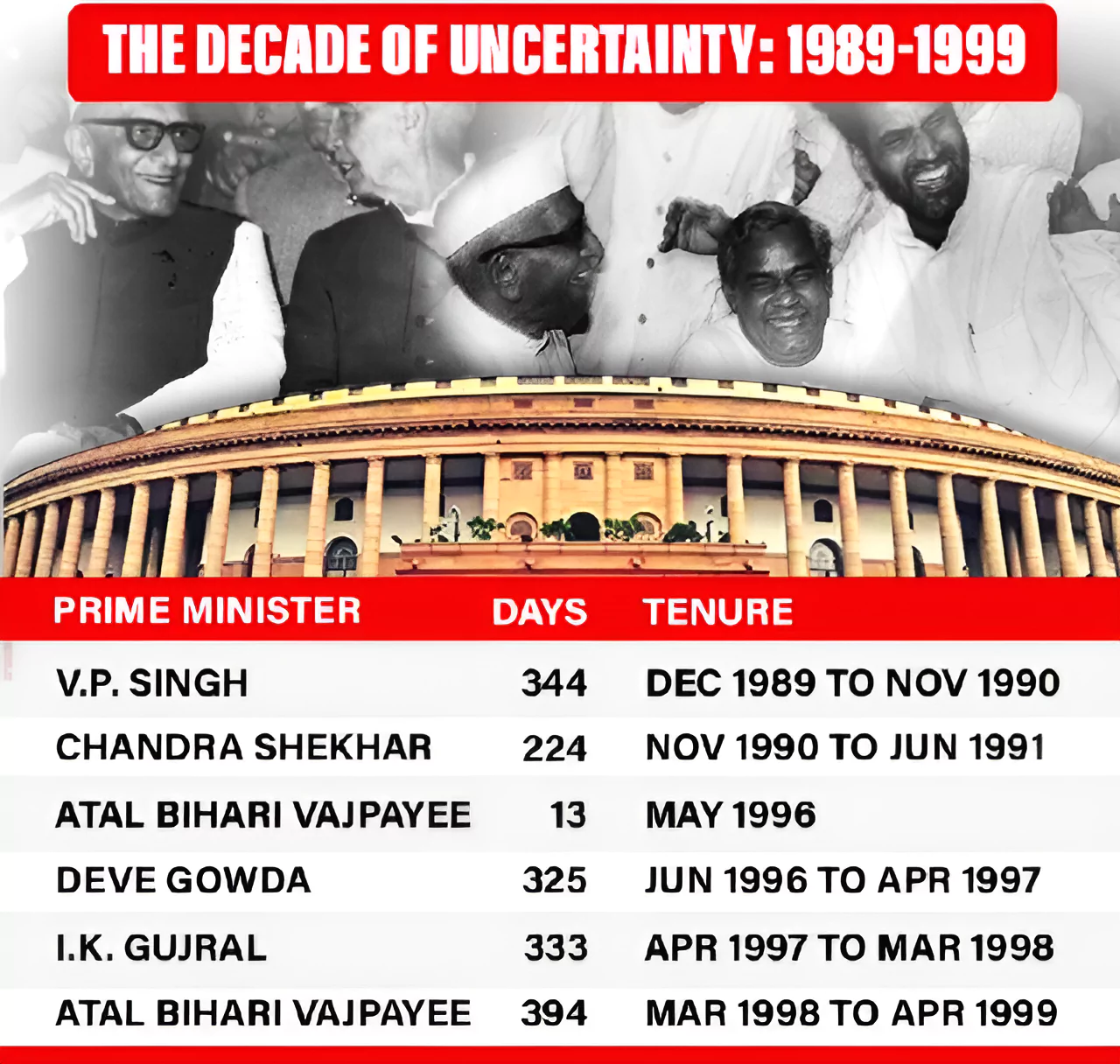
Coalition Government
A coalition government is one in which multiple political parties come together and often reduce the dominance of the party that has won the most seats.
The country saw coalition politics for 32 years of India’s 71-year electoral journey. After a 10-year break, coalition politics has returned, and so will ‘coalition dharma’, a term coined by BJP leader Atal Bihari Vajpayee.
Coalition dharma means giving due respect to coalition partners.
Enroll now for UPSC Online Course
Features of Coalition Government
A coalition government implies the existence of at least two partners.
- Coalition politics is not static but dynamic, as coalition players and groups dissolve and form new ones.
- Coalitions are formed for the sake of some reward, material or psychic.
- Pragmatism and not ideology is the hallmark of coalition politics.
Classification of Coalition Government
- Pre-poll Coalition: It is considerably advantageous because it provides a common platform for the parties to woo the electorate based on a joint manifesto.
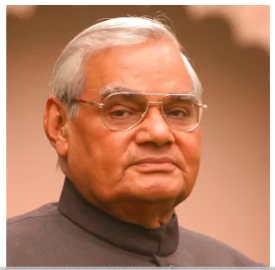 Post-poll Coalition: It enables constituents to share political power and run the government.
Post-poll Coalition: It enables constituents to share political power and run the government.- First Coalition Government at Center: The first time that Independent India saw parties stitching up a coalition government at the Centre was in 1977, right after the Emergency.
- Eleven parties, including the Bharatiya Jana Sangh (predecessor of the BJP) came together to form the Janata government. The rainbow coalition lasted till 1979.
- In India, where people have been delivering fragmented mandates for three decades, coalition politics has been the norm. For most of the 80s, 90s and the first decade of this century, no one party received a majority in the Lok Sabha
- First in India: In India, the first coalition government to complete its full term was the Atal Bihari Vajpayee-led National Democratic Alliance from 1999 to 2004.
Check Out UPSC CSE Books From PW Store
- Coalition: The term ‘coalition’ is derived from the Latin world ‘coalitio’ which means ‘to grow together’.
- Thus, technically, coalition means the act of uniting parts into one body or whole. Politically, coalition means an alliance of distinct political parties.
- Coalition Formation: Coalition usually occurs in modern parliaments when no single political party can muster a majority of votes.
- Two or more parties, who have enough elected members between them to form a majority, may then be able to agree on a common programme that does not require too many drastic compromises with their individual policies and can proceed to form a government.
- Coalition governments are formed as seldom does a political party win the necessary number of seats to form the government on its own.
|
- Implications: While some say that coalition governments generate more inclusive policies, others believe that coalitions impose constraints on policy making.
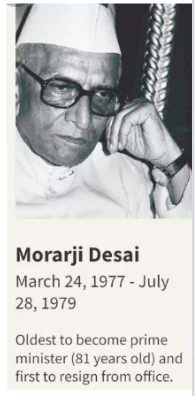 In the words of Montek Singh Ahluwalia (former Deputy Chairman of the erstwhile Planning Commission), a coalition government is a strong consensus for weak reforms.
In the words of Montek Singh Ahluwalia (former Deputy Chairman of the erstwhile Planning Commission), a coalition government is a strong consensus for weak reforms.
Formation of Coalition Governments in India
- Morarji Desai (March 1977-July 1979): Emergence of the first major coalition government in India. In 1977, the Janata Party, a coalition of opposition parties, came to power with Morarji Desai as Prime Minister.
- Charan Singh (July 1979-January 1980): He assumed office as Prime Minister on July 28, 1979.
- He was the founder of the Bharatiya Kranti Dal and former Home Minister.
- However, his tenure was short-lived as within 23 days.
- He remains the only Indian Prime Minister to date who has not faced Parliament during his tenure.
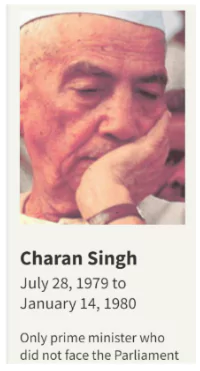 VP Singh (December 1989 – November 1990): In 1989, the National Front coalition, led by Vishwanath Pratap Singh of the Janata Dal, came into power, succeeded in 1990 by a Janata Dal (Socialist) administration under Chandra Shekhar.
VP Singh (December 1989 – November 1990): In 1989, the National Front coalition, led by Vishwanath Pratap Singh of the Janata Dal, came into power, succeeded in 1990 by a Janata Dal (Socialist) administration under Chandra Shekhar.- Chandra Shekhar (November 1990 – June 1991): Forming an alliance with the Congress, Chandra Shekhar assumed office as Prime Minister on November 10, 1990.
- HD Deve Gowda (June 1996 – April 1997): He took oath as Prime Minister on June 2, 1996. Congress extended external support to this coalition government known as the ‘United Front’.
- Inder Kumar Gujral (April 1997 – March 1998): Congress withdrew its support for the United Front government on March 30, 1997.
- Amidst the political turmoil, Inder Kumar Gujral, the former external affairs minister in the Gowda administration, emerged as the successor.
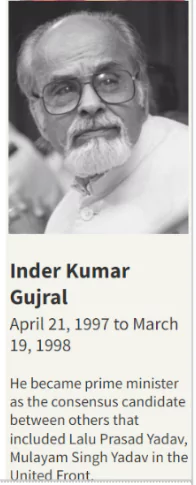 On November 28, 1997, Congress withdrew its backing for the Gujral administration, marking the end of Gujral’s seven-month tenure as Prime Minister.
On November 28, 1997, Congress withdrew its backing for the Gujral administration, marking the end of Gujral’s seven-month tenure as Prime Minister.
- Atal Bihari Vajpayee (March 1998 – May 2004): The BJP-led National Democratic Alliance (NDA) to came to power, with Atal Bihari Vajpayee as Prime Minister from 1998 to 2004.
- Manmohan Singh (May 2004 – May 2014): Congress-led United Progressive Alliance (UPA), with Manmohan Singh as Prime Minister from 2004 to 2014.
Check Out UPSC NCERT Textbooks From PW Store
Notable Reforms Brought by the Previous Coalition Governments in India
- P V Narasimha Rao-led Government:
- Economic Liberalisation: Opened the Indian economy to global completion by removing the license-permit raj.
- WTO Membership: India joined the World Trade Organisation.
- Deve Gowda Led Government:
- Dream Budget: It came out with what is still referred to as the “dream budget”. It placed faith in the Indian taxpayers and cut tax rates — both personal income tax, corporate taxes, and customs duties.
- Atal Bihari Vajpayee-led Government:
- Fiscal Responsibility & Budget Management (FRBM) Law: It framed the FRBM law for fiscal rectitude, and limited the government’s ability to borrow within prudential limits.
- Disinvestment of loss-making Public Sector Undertakings (PSUs): It further advanced the push towards disinvestment of loss-making PSUs.
- Rural Infrastructure & Connectivity: It focused on boosting rural infrastructure and connectivity through the PM Gram Sadak Yojana.
- Information Technology Act, 2000: It also brought in the Information Technology Act, in 2000, that laid the foundation for the bustling e-commerce giant that India is today.
- Manmohan Singh-led Government:
- Rights-based approach: It brought several reforms under the rights-based approach — far more robust than the personal guarantees of an individual leader.
- The Right to Information Act, which boosted transparency in India’s democracy.
- The Right to Food, which ensured that no Indian should go hungry.
- MG-NREGA: It brought in the Mahatma Gandhi National Rural Employment Guarantee Act (MG-NREGA), which provided minimum employment to the rural poor.
- Deregulation of Fuel Prices & Others: It also deregulated fuel prices before it left office and started work on direct benefit transfers as well as Aadhaar and GST.
Enroll now for UPSC Online Classes
Merits of Coalition Governments
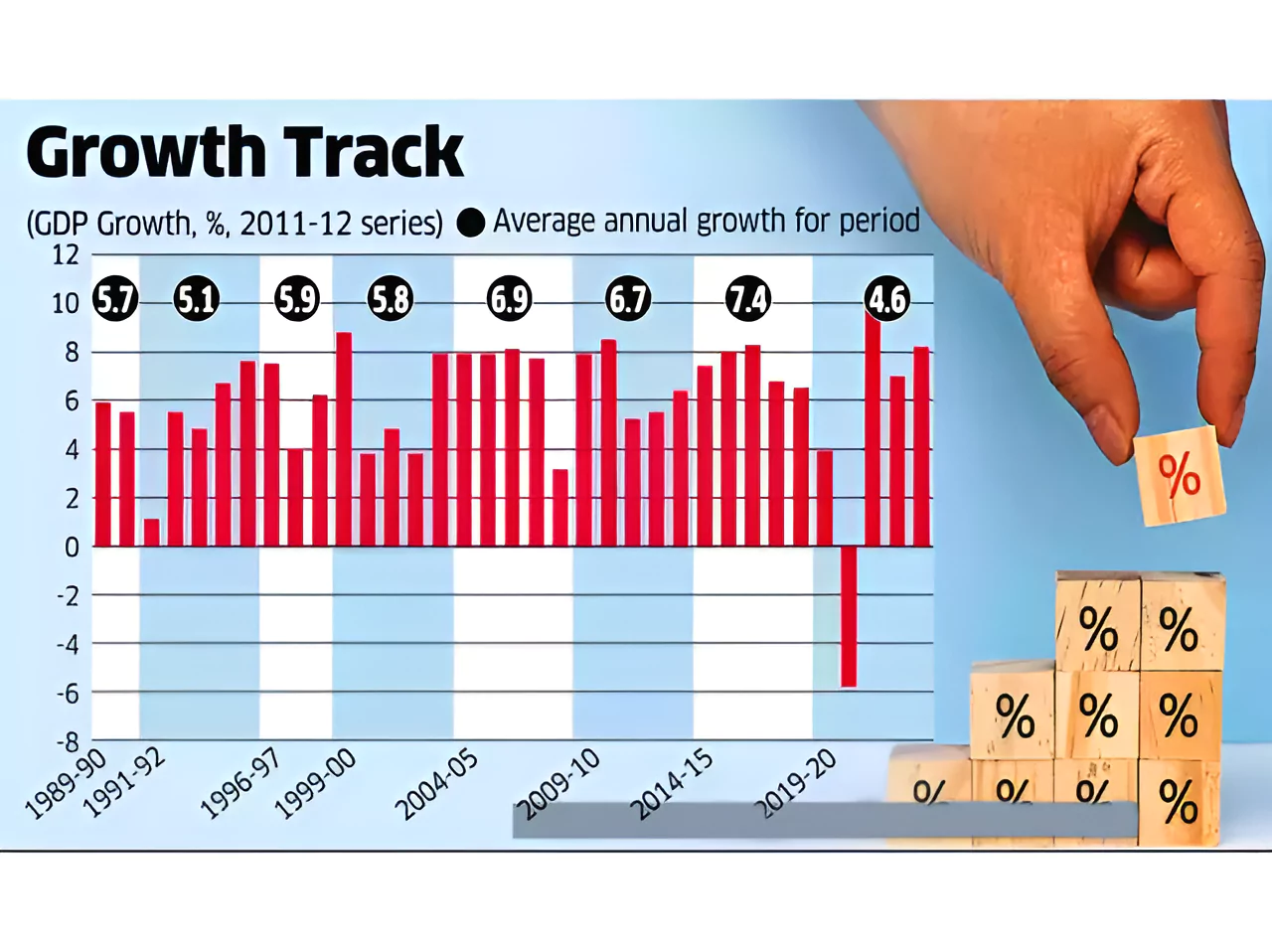
- Economic Growth: A coalition government helps in achieving high economic growth.
- The average growth rate for the 10-year period for the BJP-led majority government was 6%, including the 5.8% contraction the economy witnessed in FY21 amid Covid-related disruptions.
- The Congress-led United Progressive Alliance (UPA) government that preceded the BJP government in 2014 secured 6.7% growth in its five years, and 6.9% in the previous five years of its first term.
- The compound annual growth rate (CAGR) during the 10-year rule of the UPA at 6.8% was the fastest in India’s history.
- Growth averaged 5.6% between 1991, when the Congress led by PV Narasimha Rao formed a minority coalition with Janata Dal, and 1999 when Atal Bihari Vajpayee-led NDA returned to power for its full five-year term.
- Accommodation of Diverse Interests: In coalition governments, multiple political parties with varying agendas and priorities come together to form a government. This diversity allows for the representation of different social, regional, and ideological groups within the government.
- As a result, coalition governments may be better equipped to address the needs and aspirations of a diverse population and promote inclusivity in governance.
- Example: The United Progressive Alliance (UPA) government (2004-2014) included parties like the DMK, NCP, and RJD, representing different regions and interests.
- Checks and Balances: It require consensus-building and cooperation among coalition partners to pass legislation and implement policies.
- Promote transparency, accountability, and dialogue among political parties, contributing to more accountable and responsive governance.
- Example: The National Front government (1989- 1990), led by V.P. Singh, was a coalition that represented the anti-Congress sentiment prevalent at that time.
- Consensus-Based Politics: The government policy requires the concurrence of all the coalition partners. Therefore, a coalition government leads to consensus-based politics.
- Coalition governments made very difficult reforms, from the 73rd and 74th Amendments which brought in Panchayati Raj and municipal systems through state governments, and this continued on to the early years of Vajpayee as well.
- Example: The NDA government (1999-2004) under Prime Minister Atal Bihari Vajpayee built consensus on key issues like foreign policy and economic reforms.
- Strengthening of Federal Fabric: Coalition politics strengthens the federal fabric of the Indian political system because a coalition government is more sensitive and responsive to regional demands.
- Example: The V.P. Singh’s government set up the Interstate Council to improve cantre-state dialogue.
- It was found that the interstate council worked whenever regional political parties had a major role at the national level.
- Reduced Chances of Despotic Rule: A coalition government diminishes the dominance of any single political party in government operations. Decision-making involves participation from all coalition members.
- Example: The Janata Party government (1977-1979) ended the Congress’s single-party dominance.
- The UPA government’s decision to create the Telangana state in 2014 was a result of pressure from its coalition partner, the Telangana Rashtra Samithi (TRS).
Demerits of Coalition Governments
- Instability: Coalition governments are mostly unstable or prone to instability. Differences of opinion among coalition members can lead to the collapse of the government.
- Example: Since 1998, whenever the Lok Sabha mandate is split and a coalition comes to power, political negotiations have been complex and fraught.
- Six times, a non-Congress, non-BJP leader has been chosen as PM but has not lasted a complete five-year term.
- The Charan Singh government (1979) lasted only for a few months due to the withdrawal of support by the Congress party.
- Curtailed leadership of the Prime Minister: The Prime Minister’s leadership is constrained within a coalition government, as the Prime Minister must consult with coalition partners before making significant decisions.
- Example: Prime Minister Manmohan Singh (2004-2014) often had to consult and accommodate the views of coalition partners like the DMK and the Trinamool Congress on key policy matters.
- The undermining of Cabinet’s Role: The Coordination Committee of coalition partners functions as a ‘Super-Cabinet,’ potentially diminishing the cabinet’s role and stature in governing machinery operations.
- Example: During the UPA government, the National Advisory Council (NAC), headed by Sonia Gandhi, was seen as a parallel power centre, undermining the role of the cabinet.
- Smaller Parties playing ‘King-Maker’: Smaller coalition partners can exert disproportionate influence by making extensive demands.
- Example: In the 1996 Haryana Vikas Party, with just one MP, the party played a key role in forming the government by extending support to the BJP-led coalition.
- Regional Parties Bringing in Regional Factors: Leaders of regional parties contribute regional perspectives to national decision-making, exerting pressure on the central executive to align with their priorities.
- Example: The Dravida Munnetra Kazhagam (DMK in the UPA government often pressured the central government to take a favorable stand on issues related to Sri Lankan Tamils.
- Lack of Responsibility for Failures: Coalition governments often evade accountability for administrative failures and lapses by engaging in blame games, thus avoiding both collective and individual responsibilities.
- Example: During the 2G spectrum scam 2011, coalition partners of the UPA government, like the DMK, tried to distance themselves from the scandal, blaming the Congress party for the lapses.
- Faltered on Inflation: Data from the last three decades show that coalition governments have struggled to keep inflation in check.
- Example: Inflation for industrial workers was 5.4% during the last decade, when the BJP had an absolute majority, but it was 10.3% for UPA’s second stint and 6% in the first one.
- While it was low for Vajpayee’s years between 1999 and 2004, industrial worker inflation was 9.6% between 1991 and 1999.
Check Out UPSC Modules From PW Store
Recommendations on Coalition in India
- Recommendations by Punchhi Commission: It established clear rules for Governors to handle appointing Chief Ministers in hung assemblies and hold true for the President as well.
- If there is a pre-poll coalition, it should be treated as one political party. If such a coalition obtains a majority, the governor shall call the leader of such coalition to form the Government.
- In case no party or pre-poll coalition has a clear majority, the Governor should select the Chief Minister in the following mentioned order:
- The group of parties that have pre-poll alliances have the largest number.
- The largest single party claims to form the government with the support of others.
- A post-electoral coalition with all partners joining the government
- A post-electoral coalition with some parties joining the government and the remaining, including independents supporting the government from outside
- Sarkaria Commission: It found that problems in Indian federalism came from a lack of consultation and dialogue between the Centre and states.
- It signifies the role of coalition government in which regional parties play an important role.
- Justice M N Venkatachaliah Commission Report: It has suggested the idea of a permanent coalition and that it would be best if all governments in India mandatorily achieved a 50-plus vote share.
- It meant that only a government with a 50-plus % vote share would have the necessary legitimacy to govern.
|
Conclusion
India’s unique diversity makes it a social and political coalition like no other. Coalition governments need to take everyone along and have tended to be more liberal, more consensual and more respectful of federalism. Coalition governments in India, despite their challenges, have historically driven significant reforms and balanced diverse interests, contributing to robust economic and social progress.
Enroll now for UPSC Online Course
![]() 7 Jun 2024
7 Jun 2024
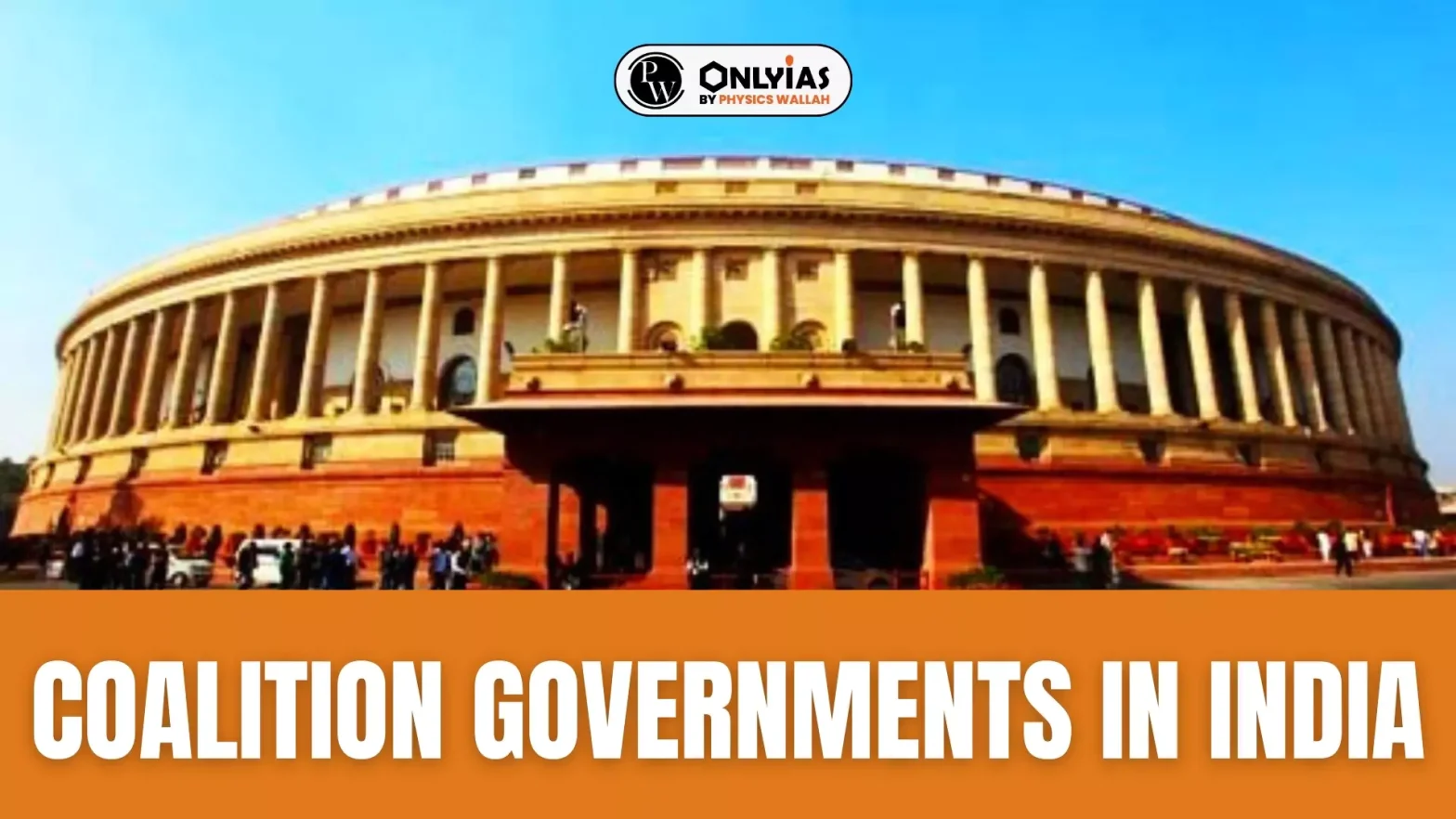

 Post-poll Coalition: It enables constituents to share political power and run the government.
Post-poll Coalition: It enables constituents to share political power and run the government. In the words of Montek Singh Ahluwalia (former Deputy Chairman of the erstwhile Planning Commission), a coalition government is a strong consensus for weak reforms.
In the words of Montek Singh Ahluwalia (former Deputy Chairman of the erstwhile Planning Commission), a coalition government is a strong consensus for weak reforms. VP Singh (December 1989 – November 1990): In 1989, the National Front coalition, led by Vishwanath Pratap Singh of the Janata Dal, came into power, succeeded in 1990 by a Janata Dal (Socialist) administration under Chandra Shekhar.
VP Singh (December 1989 – November 1990): In 1989, the National Front coalition, led by Vishwanath Pratap Singh of the Janata Dal, came into power, succeeded in 1990 by a Janata Dal (Socialist) administration under Chandra Shekhar. On November 28, 1997, Congress withdrew its backing for the Gujral administration, marking the end of Gujral’s seven-month tenure as Prime Minister.
On November 28, 1997, Congress withdrew its backing for the Gujral administration, marking the end of Gujral’s seven-month tenure as Prime Minister.